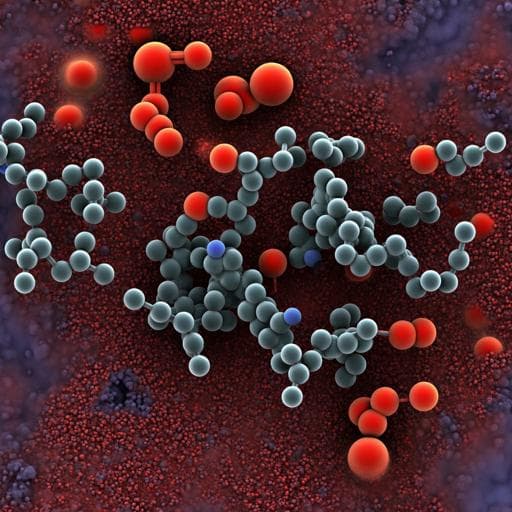
Chemistry
On the origin of multihole oxygen evolution in haematite photoanodes
G. Righi, J. Plescher, et al.
This innovative study dives into the multihole oxygen evolution reaction mechanism in haematite photoanodes, revealing a surprising third-order dependence on surface hole density. Conducted by prominent researchers including Giulia Righi and Robert Schlögl, this research employs advanced techniques like DFT simulations and microkinetic modelling to shed light on complex oxidation processes.
~3 min • Beginner • English
Introduction
This work addresses why the photoelectrochemical OER on semiconducting metal oxides such as hematite (α-Fe2O3) exhibits a multihole, power-law dependence on surface hole density, in contrast to classical single-site PCET mechanisms. In natural photosystem II, the OER proceeds via storage of multiple oxidizing equivalents at a Mn4CaO5 cluster before O–O bond formation. For heterogeneous oxide catalysts, detailed operando structural insight is limited. Prior models emphasize sequential one-electron PCET steps at metal sites, with O–O formation via nucleophilic attack on metal–oxo species. However, transient spectroscopies on hematite and other oxides reported that OER rates scale as a power law in accumulated surface holes, with first-order behavior at low hole density and third-order at higher density. The purpose here is to elucidate, at atomic level, the mechanism behind multihole behavior on hematite photoanodes and rationalize the observed third-order dependence.
Literature Review
Classical DFT-based OER models describe four PCET steps converting surface –OH to –O, –OOH, –OO, and ultimately releasing O2 via nucleophilic attack of water or OH−. While successful for trend analyses, evidence has emerged for alternative pathways: lattice-oxygen participation in some perovskites, and O–O coupling between two oxo/oxyl ligands on certain oxides. For photoanodes (α-Fe2O3, TiO2, BiVO4, WO3), Durrant and co-workers observed the OER rate following a power law in surface hole density, switching from first to third order as hole density increases. Operando spectra detected Fe(IV)=O on hematite, and recent IrO2 studies found exponential dependence of rate on surface holes, attributed to a large decrease of the O–O formation barrier with hole coverage. These findings highlight the pivotal role of hole accumulation at catalyst surfaces, motivating a mechanistic reassessment for hematite.
Methodology
Experimental: α-Fe2O3 films (~200 nm; particle size 50–100 nm) were electrodeposited on F:SnO2 and annealed at 800 °C for 20 min. Photoelectrochemical measurements used 1 M KOH (pH 13.8) in a three-electrode cell (Ag/AgCl reference, Pt counter). Transient photocurrent under chopped 450 nm illumination was recorded at 0.76, 1.01, 1.26, and 1.51 V_RHE across a wide laser power range. Photocurrent transients were integrated to quantify accumulated holes; fitting also yielded double-layer charge to approximate surface holes, excluding diffusion-limited contributions.
Computations: DFT models of the α-Fe2O3(0001)/water interface focused on the hydroxylated O termination. Surface dehydrogenation via PCET was evaluated using the computational hydrogen electrode with solvation from first-principles MD (FPMD). Band alignment estimated E_VBM ≈ 1.91 V_RHE. Electronic structure: hybrid PBE0 with αx=0.12 was used to characterize hole localization and for TDDFT optical spectra of surface-hole states; bulk/surface calculations employed QUANTUM ESPRESSO with rVV10 vdW and Hubbard U(Fe)=4.3 eV, 2×2 and 4×4 slabs (6 Fe layers), plane-wave cutoff 80 Ry, NEB with 10–12 images. Transition states and activation energies for O–O bond formation were computed for multiple coverages of surface oxyls (denoted *O or O•). Solvent and ions (OH−, Na+) were included explicitly for alkaline pathways. Thermodynamic integration FPMD at 350 K validated NEB barriers for a key OH− dissociation pathway.
Microkinetic modeling: A steady-state TST-based microkinetic model included ten steps: four PCET steps (1–4), chemical O2 release (5), water dissociation routes (6–7), OH−-assisted routes (8–9), and hole-driven oxidation of surface O2 species (10). Activation and reaction energies were coverage-dependent via linear fits to NEB/FPMD data. Conditions: pH 8, T=300 K, X_H2O=1, X_O2=10^−7; SCL-hole concentration C(h*) treated as a parameter, with hole diffusion barrier E_diff,h taken as 0.29 eV (variations analyzed in supplement). Turnover frequency r_OER defined as sum of rates of steps (4) and (5).
Key Findings
- Experimental kinetics: OER current scales nearly with the third power of accumulated charge/surface hole density over four orders of magnitude in current across 0.76–1.51 V_RHE. Using double-layer charge to approximate surface holes removes low-intensity bending; reaction order remains near three, largely independent of bias.
- Surface-hole identity: DFT shows PCET dehydrogenation forms surface oxyl/Fe(IV)-oxo-like states with the hole shared between surface O and subsurface Fe. TDDFT spectra of this “O•” state match the TAS fingerprint (broad band peaking ~643 nm), consistent with long-lived surface holes correlating with OER rate; subsurface Fe(IV) and bulk holes may contribute less pronounced features.
- O–O bond formation energetics: Water-involving routes (6–7) have high barriers (~0.9–1.4 eV at coverages of 2–4 O•), inconsistent with low experimental apparent activation energies. PCET nucleophilic attack (2) via OH− has lower barriers (0.43 → 0.13 eV as O• increases from 1 to 3), but OH− dissociative adsorption on multisite oxyl ensembles dominates: hydroperoxo via OH− (8) has barriers 0.23–0.16 eV (2–3 O•); superoxo via OH− (9) requires three O• and has barrier ~0.16 eV at 3 O•, decreasing to ~0.02 eV at high coverage. The dependence of barrier on coverage is weak for OH−-involving steps.
- Microkinetic outcomes: Using coverage-dependent parameters, r_OER follows r = k_OER [*O*]^α with α ≈ 3.07 (≈3.20 in initial fit). Apparent activation energy E_app ≈ 0.18 eV at C(h*)=1 ML. Degree of rate control analysis shows step (9) (OH− dissociation to superoxo on 3 *O sites) dominates O–O formation; O2 release proceeds via step (5). At high C(h*), step (1) (surface PCET to form *O) has the highest DRC (hole diffusion-limited); at low C(h*), step (9) controls (limited by availability of three neighboring *O). The model predicts rate increases with pH (OH− involvement) and roughly linear scaling with light intensity (first order in SCL holes when step (1) is not quasi-equilibrated).
- Mechanistic picture: The OER proceeds by sequential one-electron oxidations accumulating three surface holes at neighboring sites, enabling low-barrier OH− dissociative chemisorption to form a surface superoxo. A small BEP slope (<0.1) for step (9) indicates an early transition state and explains the near power-law dependence on hole coverage, contrasting with IrO2 where a large BEP slope (~0.9) yields exponential dependence.
Discussion
The study resolves the origin of multihole kinetics in hematite photoanodes: a multisite mechanism requiring three proximate surface oxyls enables facile O–O formation via OH− dissociation, producing a third-order rate dependence on surface holes. This directly addresses the discrepancy between classical single-site PCET models and TAS/transient photocurrent observations. The weak coverage dependence of the key activation barrier accounts for power-law behavior, distinguishing hematite from metallic oxides (e.g., IrO2) where barriers decrease strongly with hole coverage and rates are exponential in hole density. The mechanism parallels nature’s OEC, in which oxidizing equivalents are accumulated at multiple metal–oxo sites before O–O coupling. pH trends emerge naturally from OH− involvement in the rate-controlling steps, while deviations reported in literature can be rationalized by shifts in the step with highest degree of rate control (e.g., hole diffusion or steps not involving OH−). Overall, integrating experiment, atomistic simulations, and microkinetics provides a coherent mechanistic framework for hematite’s multihole OER.
Conclusion
The OER on hematite photoanodes exhibits an approximate third-order dependence on surface hole density due to a multisite pathway: sequential PCET steps accumulate three holes at neighboring oxyl sites that enable low-barrier, OH−-assisted O–O bond formation to a superoxo intermediate. Calculations reproduce the TAS fingerprint of surface holes and, together with microkinetic modeling, explain the observed kinetics, low apparent activation energy (~0.18 eV), pH dependence, and near-linear light-intensity scaling. This mechanism establishes a strong analogy with biological OER in PSII and marks a departure from traditional single-site models. Future work should explicitly incorporate surface acid–base equilibria, space-charge layer hole generation/recombination/diffusion, and pH-dependent energetics, and further validate intermediates under operando conditions, to generalize these insights across oxide photoanodes.
Limitations
- The microkinetic model is simplified: it does not explicitly model hole generation, recombination, and diffusion within the space-charge layer or its spatial profile; SCL-hole concentration is treated parametrically.
- Surface acid–base chemistry and pH-dependent surface charging at the interface are not included; pH enters only via OH− concentration in rate expressions.
- Static NEB barriers rely on single solvent snapshots; although validated by thermodynamic integration for a key step, solvent dynamics and configurational sampling may introduce uncertainties.
- Coverage dependence of some barriers was extrapolated (e.g., from higher coverages in small cells), potentially affecting low-coverage behavior.
- DFT results depend on the chosen functionals and parameters (e.g., PBE0 αx=0.12, rVV10, Hubbard U), which may influence hole localization and energetics.
- The affiliation corresponding to author superscript 7 is not provided in the available text.
Related Publications
Explore these studies to deepen your understanding of the subject.







